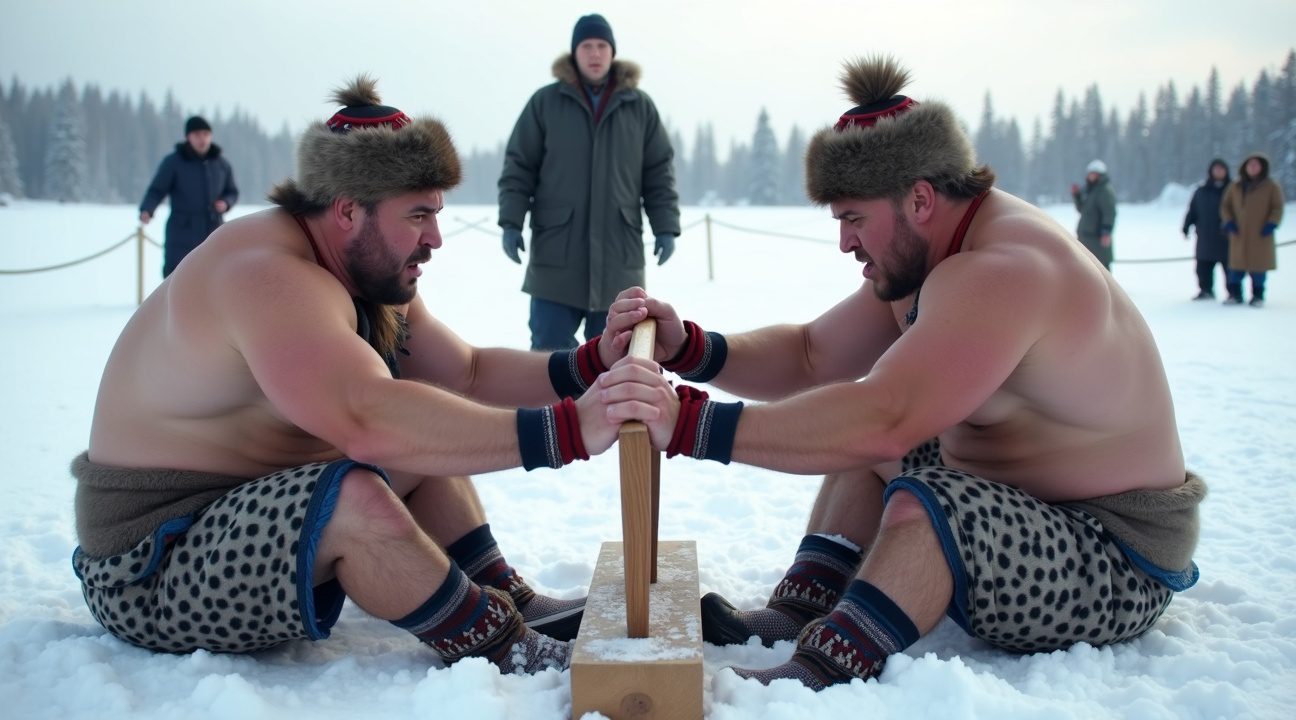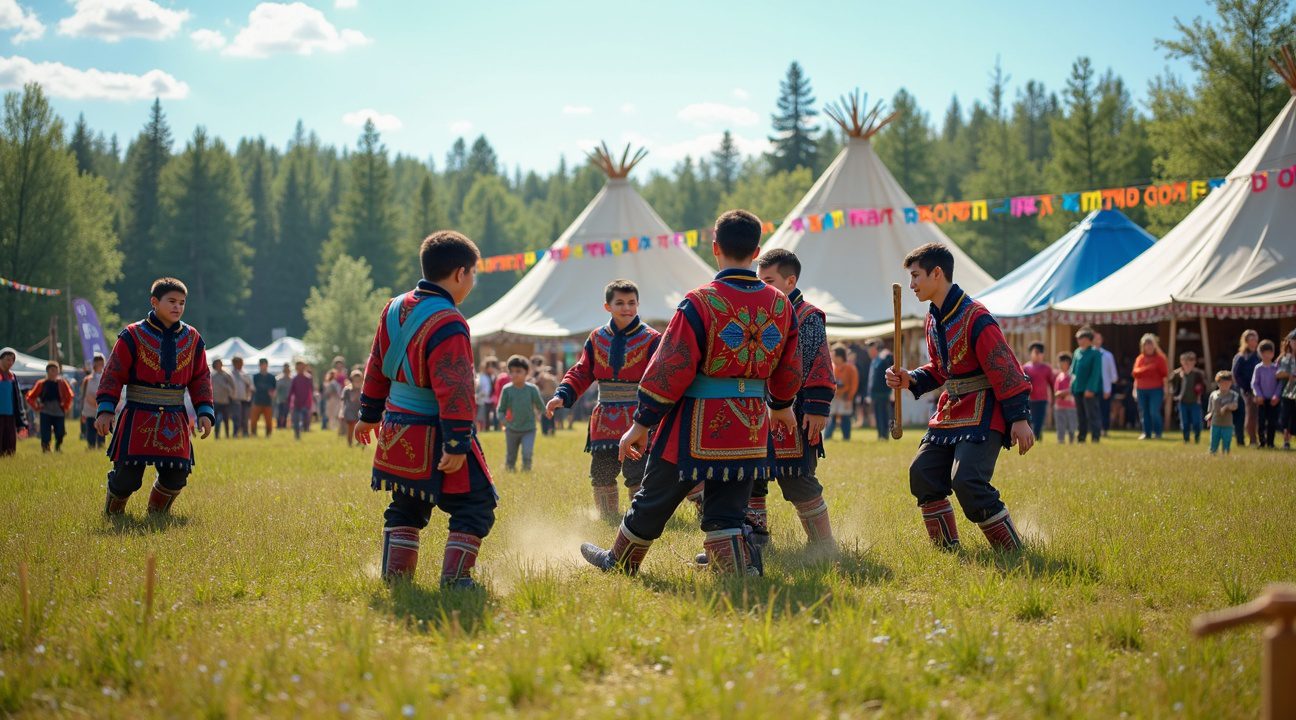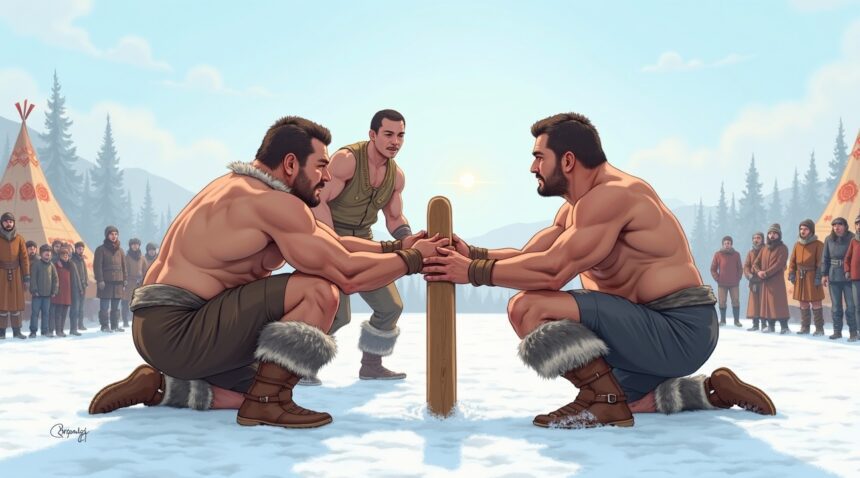Yakut sports represent a fascinating collection of traditional Arctic athletic disciplines that emerged among the Sakha people of Siberia. These competitions serve as both cultural preservation methods and practical survival training for one of Earth’s most challenging climates.
Sports like mas-wrestling and khapsagai wrestling have transformed from essential survival skills into internationally recognized competitions. Each discipline maintains its deep cultural significance and traditional protocols.
Key Takeaways
- Mas-wrestling stands as a stick-pulling competition where two athletes sit across from each other and attempt to either pull the stick from their opponent’s grip or pull them over a dividing board, emphasizing technique and leverage over pure strength.
- Khapsagai wrestling emphasizes agility and quick reflexes rather than brute force, traditionally performed on natural surfaces like grass or earth, with roots dating back to 18th-century warrior training methods.
- Environmental adaptation shaped these sports as practical training for Arctic survival, developing grip strength for handling tools in sub-zero temperatures, core stability for icy terrain movement, and explosive power for emergency situations.
- Cultural preservation remains central to modern practice, with competitions maintaining traditional Yakut language commands, ceremonial protocols, and authentic equipment specifications to transmit Sakha heritage to younger generations.
- Diverse athletic traditions extend beyond wrestling to include traditional jumping competitions, archery, and strategic table games, creating a comprehensive physical and mental training system that reflects the versatility required for traditional Yakut life.
Origins and Environmental Relevance
The Sakha people developed these athletic traditions out of necessity. Arctic survival demanded specific physical capabilities that regular daily activities couldn’t fully develop. Mas-wrestling built the grip strength needed to handle frozen tools and weapons. Khapsagai wrestling developed the balance and agility required to move safely across ice and snow. Each sport addressed particular survival challenges while building community bonds through shared competition.
Preservation and Tradition
Modern practitioners continue these traditions with remarkable dedication to authenticity. Competitions follow ancient rules and protocols. Equipment specifications mirror traditional materials and construction methods. Ceremonial elements preserve the spiritual aspects that originally connected these sports to the Sakha worldview and values.
Global Recognition and Challenges
International recognition has brought new opportunities for cultural exchange while creating challenges for maintaining authenticity. Competition organizers work carefully to balance global appeal with traditional integrity. Athletes train using both ancient techniques and modern sports science to excel in international competitions.
Continued Adaptation
The Arctic environment continues to influence how these sports develop. Climate considerations affect training schedules, competition timing, and equipment adaptations. Athletes must understand both traditional wisdom and contemporary training methods to succeed at the highest levels.
Interdisciplinary Insights
These disciplines offer unique insights into human adaptation and cultural transmission. Scientists study how these sports developed specific physiological adaptations suited to Arctic conditions. Anthropologists examine how athletic traditions preserve cultural knowledge across generations. Sports psychologists investigate how traditional competitive practices build mental resilience.
Mas-Wrestling: The Art of Stick Pulling That Tests Arctic Strength
I find mas-wrestling to be one of the most fascinating displays of raw strength and technique in traditional Arctic sports. Two competitors sit directly across from each other, placing their feet firmly against a wooden board that separates them. They grip a small wooden stick between their hands, engaging in what becomes an intense battle of wills and physical prowess.
The objective appears deceptively simple: either wrench the stick completely from your opponent’s grasp or pull them forward over the dividing board. However, the execution demands exceptional grip strength, core stability, and strategic technique. Athletes can’t rely solely on brute force – smaller competitors often defeat larger opponents through superior positioning and leverage.
Essential Equipment and Official Rules
The sport requires minimal but precisely regulated equipment. The wooden stick features specific length and diameter measurements defined by official competition standards. I’ve observed that the stick’s dimensions create the perfect balance between grip comfort and competitive challenge. The sturdy wooden board between competitors must meet exact specifications to ensure fair play and safety.
Footwear plays a crucial role in performance, as athletes need proper traction against the foot board while maintaining stability during intense pulling motions. Competition organizers strictly enforce equipment regulations to maintain the sport’s integrity and ensure equal conditions for all participants.
Competition Structure and Commands
Official matches follow a precise protocol that preserves the sport’s cultural authenticity. Referees issue commands exclusively in the Yakut language, connecting modern competitions to their traditional roots. The sequence begins with “Belem,” instructing competitors to ready themselves and establish their grip. Following this preparation phase, the referee calls “Che,” signaling the start of active pulling.
Weight categories ensure fair competition across different body types and sizes, following international standards that accommodate both male and female athletes. These divisions recognize that while strength in combat sports varies significantly, technique often trumps size in mas-wrestling competition.
The sport’s formal recognition came through the Yakut Council for Physical Culture and Sport in 1926, establishing official competition regulations that have guided the discipline since 1959. This standardization helped preserve mas-wrestling’s traditional elements while creating a framework for modern competitive events.
Historical records trace mas-wrestling’s origins to the 17th century, first documented by Siberian explorers who witnessed these strength contests among indigenous populations. The practice developed as both entertainment and a practical measure of physical capability in harsh Arctic conditions. Traditional Yakut communities used mas-wrestling to identify individuals capable of handling the demanding physical challenges of survival in extreme climates.
Athletes develop specific training regimens focusing on grip endurance, core strength, and pulling power. Unlike sports that emphasize cardiovascular fitness, mas-wrestling demands sustained anaerobic strength over relatively short durations. Competitors often train with specialized grip-strengthening exercises and weighted pulling movements that simulate match conditions.
The mental aspect proves equally important, as competitors must maintain focus while experiencing intense physical strain. Matches can extend for several minutes, testing both physical endurance and psychological resilience. Successful athletes develop the ability to maintain maximum effort while reading their opponent’s fatigue levels and adjusting strategy accordingly.
Modern mas-wrestling has expanded beyond its Arctic origins, attracting practitioners worldwide who appreciate the sport’s unique combination of strength, technique, and cultural heritage. International competitions now feature athletes from diverse backgrounds, though Yakut competitors often demonstrate superior technique refined through generations of practice.
The sport continues evolving while maintaining its traditional foundation, incorporating modern training methods and competitive structures without losing the essential character that makes mas-wrestling a distinctly Arctic discipline.
https://www.youtube.com/watch?v=rOErCjwolAw

Khapsagai Wrestling: The Combat Sport Born from Yakut Legends
Khapsagai wrestling stands as one of the most distinctive martial arts to emerge from the Sakha Republic, representing far more than simple physical competition. I’ve discovered this ancient practice serves fundamentally as “a competition in agility,” emphasizing nimbleness and quick reflexes over brute strength. The sport derives directly from training methods designed for martial conflict in early Yakut society, where warriors needed to develop lightning-fast responses and exceptional balance.
Historical documentation traces Khapsagai’s roots back to the 18th century, with the earliest references appearing in accounts of the Yhyakh festival from 1737. Historians G.F. Miller and V.F. Miller provided detailed descriptions of these wrestling matches, documenting how the sport functioned as both entertainment and competitive training during traditional celebrations. Their observations reveal how deeply embedded this practice was within Sakha culture, much like how Japanese spectators clean stadiums as part of their sporting traditions.
Traditional Rules and Modern Adaptations
Khapsagai matches traditionally occur on natural surfaces, taking place on grass or earth rather than formal mats. I find this choice particularly significant, as it maintains the sport’s connection to its origins while testing wrestlers’ ability to adapt to varying ground conditions. The rules remain minimal, with few restrictions beyond the fundamental requirement of showing traditional respect for one’s opponent.
Modern competitions have necessarily evolved from their historical counterparts. Originally, the techniques included extremely tough methods intended for actual combat situations, similar to how martial arts competitions have adapted traditional fighting styles. Today’s Khapsagai matches prioritize safety while preserving the sport’s essential character and technical requirements.
Weight categories don’t traditionally exist in Khapsagai, reflecting its origins as a skill-based rather than size-dependent discipline. However, larger modern events sometimes introduce divisions to ensure fair competition, though these additions respect the sport’s emphasis on agility over physical mass.
The cultural significance cannot be understated. Khapsagai wrestling maintains deep connections to Sakha legends and oral traditions, serving as a living link to the martial readiness that once defined survival in the harsh northern territories. Each match embodies centuries of cultural evolution, preserving techniques and philosophies passed down through generations while adapting to contemporary sporting standards.
This wrestling form continues to demonstrate the ingenuity of the Sakha people in developing martial arts perfectly suited to their environment and cultural needs, creating a sport that celebrates both physical prowess and cultural heritage.
The Harsh Siberian Climate That Shaped Yakut Athletic Traditions
The Arctic environment of the Republic of Sakha has forged one of the world’s most distinctive athletic cultures. I observe how the Yakuts, also known as the Sakha people, developed their sporting traditions not merely as entertainment, but as essential survival training for life in one of Earth’s most unforgiving climates.
The extreme temperatures that plunge below -60°C during winter months demanded extraordinary physical preparation from the Sakha people. Their bodies needed to maintain strength and flexibility even when exposed to conditions that would incapacitate inhabitants of temperate regions. Mas-wrestling emerged from this necessity, requiring participants to develop the core strength and balance crucial for maintaining stability on icy terrain while carrying heavy loads or hunting in treacherous conditions.
Traditional Yakut sports function as comprehensive physical conditioning systems that address every aspect of Arctic survival. The explosive power required in mas-wrestling directly translates to the ability to quickly extract oneself from dangerous situations, such as breaking through thin ice or escaping from predators. Similarly, the endurance components of these activities mirror the sustained energy needed during long hunting expeditions or migrations across vast frozen landscapes.
Physical Adaptations Born from Environmental Demands
The development of Yakut athletic traditions reflects specific adaptations to Siberian challenges. Competitors in traditional Yakut sports must demonstrate:
- Exceptional grip strength for handling tools and weapons in sub-zero temperatures
- Core stability to maintain balance on uneven, ice-covered surfaces
- Explosive power for quick movements in heavy winter clothing
- Mental fortitude to perform under extreme physical stress
- Flexibility to avoid injury when working in restrictive cold-weather gear
The training methods employed by Yakut athletes mirror the daily activities required for Arctic survival. Wrestling movements simulate the grappling techniques needed when hunting large game or defending against predators. The cardiovascular demands of these sports prepare participants for the sustained physical effort required during seasonal migrations or emergency situations where rapid travel across frozen terrain becomes necessary.
Modern practitioners of Yakut sports continue to benefit from these time-tested training methods, even as their daily lives have evolved beyond subsistence hunting and herding. The conditioning gained through mas-wrestling and related activities provides athletes with exceptional functional strength that transfers to contemporary athletic pursuits. Martial arts competitors often incorporate similar strength-building techniques into their training regimens.
Environmental factors shaped every aspect of traditional Yakut athletic development. The short summer season compressed training periods, requiring intensive preparation methods that maximized physical gains within limited timeframes. Athletes learned to maintain peak conditioning through long winter months when outdoor training became impossible, developing mental discipline that complemented their physical prowess.
The integration of survival skills with athletic competition created a unique sporting culture where performance directly correlated with life-or-death preparedness. Unlike modern sports competitions that emphasize specialized skills, Yakut traditions demanded comprehensive physical development that addressed multiple survival scenarios simultaneously. This holistic approach produced athletes capable of exceptional feats of strength and endurance while maintaining the practical skills necessary for Arctic survival.
Temperature extremes influenced not only the physical demands of Yakut sports but also their seasonal timing and ceremonial significance. Competitions often coincided with crucial calendar events such as hunting season preparations or community celebrations marking survival through another harsh winter. These traditions reinforced the connection between athletic achievement and community survival, elevating sports beyond individual accomplishment to collective cultural preservation.
The legacy of climate-adapted athletic traditions continues to influence modern Yakut sporting culture, where practitioners maintain connections to their ancestral survival heritage while participating in contemporary competitive formats. This unique blend of practical conditioning and cultural preservation ensures that traditional Yakut sports remain relevant training methods for anyone seeking to develop functional strength and mental resilience in challenging environmental conditions.
Beyond Wrestling: The Full Spectrum of Yakut Athletic Culture
Traditional Athletic Disciplines That Define Yakut Sporting Heritage
The rich tapestry of Yakut athletic traditions extends far beyond wrestling, encompassing a diverse array of competitions that showcase the practical skills essential for survival in Siberia’s harsh environment. I find these additional sports particularly fascinating because they demonstrate how physical prowess intertwined with daily life necessities among the Yakut people.
Yakut national jumps represent one of the most distinctive elements of this athletic culture. These dynamic jumping contests have maintained their cultural significance since formal inclusion in modern tournaments and cultural festivals beginning in 1932. Athletic organizers revived these competitions during the Soviet era, incorporating them into student competitions and all-Russian tournaments by 1968. The jumps require exceptional leg strength and coordination, skills that historically proved invaluable for traversing the uneven, frozen terrain of the Yakut homeland.
Traditional Yakut archery forms another cornerstone of the athletic tradition. Unlike modern competitive archery, this discipline maintains deep connections to hunting practices essential for survival in the subarctic climate. Practitioners use traditional equipment crafted according to ancestral specifications, with bows designed specifically for the environmental conditions of the Sakha Republic. The precision and technique required for Yakut archery directly translated to hunting success, making this sport both recreational and practical.
Khaamyska represents the table games component of Yakut sporting culture. These strategic competitions require mental acuity and tactical thinking, skills that complement the physical demands of other traditional sports. Each game follows specific rules passed down through generations, with traditional equipment carved from locally available materials. Players must master various game variations, each presenting unique challenges that develop different aspects of strategic thinking.
The diversity within Yakut athletic culture illustrates how these competitions served multiple purposes beyond entertainment. Wrestling might dominate discussions of combat sports excellence, but Yakut traditions show how entire communities maintained fitness through varied athletic pursuits. Each discipline demanded different physical and mental capabilities, ensuring comprehensive development of skills necessary for traditional Yakut life.
Modern practitioners continue honoring these traditions while adapting competitions for contemporary settings. Cultural festivals regularly feature demonstrations of all these sports, allowing younger generations to experience their heritage firsthand. Universities and cultural organizations actively promote these activities, recognizing their importance for maintaining Yakut identity in an increasingly connected world.
The traditional equipment used across these disciplines reflects the ingenuity of Yakut craftsmanship. Artisans create jumping aids, archery equipment, and gaming pieces using techniques refined over centuries. These implements aren’t merely functional but also represent artistic expression, with intricate designs that tell stories of Yakut culture and history.
Modern tournament organizers have successfully integrated these traditional sports into contemporary competitive formats without compromising their cultural integrity. International cultural exchanges now feature Yakut athletic demonstrations, introducing global audiences to these unique sporting traditions. This exposure helps preserve the sports while potentially inspiring new participants from diverse backgrounds.
The practical foundations underlying each sport remain evident in modern practice:
- Jump training develops the explosive power needed for winter mobility across snow and ice.
- Archery hones the precision crucial for hunting in challenging conditions.
- Strategic games sharpen the decision-making skills essential for survival in harsh environments.
Contemporary Yakut athletes often excel across multiple disciplines, maintaining the traditional expectation that community members develop diverse physical capabilities. This cross-training approach produces remarkably well-rounded athletes who embody the versatility valued in traditional Yakut society.
Cultural preservation efforts ensure these sports maintain their authenticity while remaining accessible to new generations. Educational programs teach proper techniques alongside the historical context that gives these activities their deeper meaning. Through this comprehensive approach, Yakut athletic culture continues thriving as a living tradition rather than a historical curiosity.
https://www.youtube.com/user/BeyondWrestling/featured
Preserving Sakha Heritage Through Sport in the Modern World
I observe how Yakut sports function as powerful vessels for transmitting Sakha cultural values to younger generations. These traditional competitions teach resilience, respect for elders, and connection to ancestral wisdom through physical practice rather than classroom instruction. Young participants don’t simply learn athletic techniques; they absorb fundamental principles of Sakha identity that have sustained communities through centuries of environmental and social challenges.
Cultural revival movements among indigenous peoples worldwide mirror what’s happening with Sakha sports traditions. Indigenous communities across North America, Australia, and Northern Europe utilize traditional games and competitions to strengthen cultural bonds and resist assimilation pressures. The Sakha people have embraced this approach, using mas-wrestling and other traditional sports as anchors for broader cultural preservation efforts.
International recognition of mas-wrestling has created unprecedented opportunities for cultural transmission beyond Yakutia’s borders. World championships now showcase Sakha traditions on global stages, with athletes serving as cultural ambassadors. This recognition validates traditional practices that colonization and modernization once threatened to erase. Competition organizers deliberately maintain authentic elements, requiring referees to use traditional Yakut terminology even in international events.
Cultural Festivals as Educational Platforms
Festivals combining sports competitions with cultural performances create immersive educational experiences for participants and spectators alike. These events feature traditional storytelling, music, crafts, and foods alongside athletic competitions. Young people engage with their heritage through multiple sensory experiences, making cultural learning memorable and meaningful. I see how these festivals function differently from academic programs – they create emotional connections through shared experience and community celebration.
Competition formats deliberately preserve traditional protocols and ceremonies that accompany each sport. Opening rituals invoke ancestral spirits and acknowledge the sacred nature of competition. Victory celebrations follow ancient customs that honor both winners and opponents. These ceremonial elements distinguish Yakut sports from purely athletic pursuits, emphasizing their role as cultural practice.
Modern innovations enhance traditional sports without compromising their cultural core. Television broadcasts include cultural education segments explaining historical context and spiritual significance. Social media campaigns share athlete stories that highlight personal journeys connecting with Sakha identity. Training programs incorporate traditional preparation methods alongside modern athletic science, creating bridges between ancestral wisdom and contemporary knowledge.
Elite athletes who excel in traditional sports often become cultural educators and advocates. Their success provides platforms for discussing broader Sakha history, environmental stewardship, and community values. Athletes serve as role models who demonstrate how traditional practices can thrive in modern contexts. This visibility inspires pride among Sakha youth while educating global audiences about indigenous cultures that mainstream media often overlooks.
https://www.youtube.com/watch?v=E4GvddLTrAw

Sources:
mas-wrestling.com
4medicine.pl
teoriya.ru
s-vfu.ru


